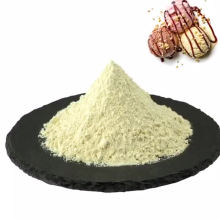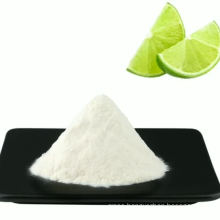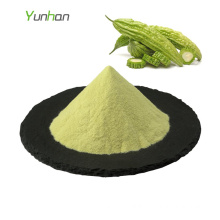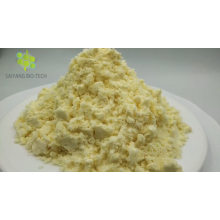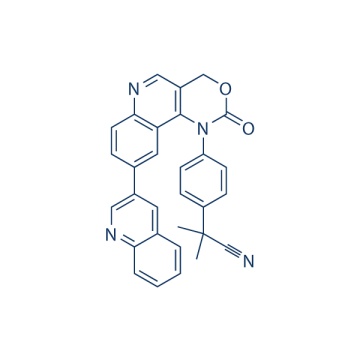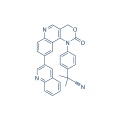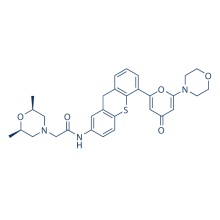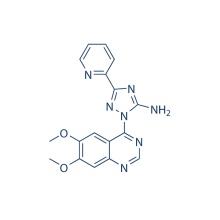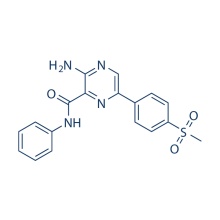ETP-46464 1345675-02-6
Product Description
.cp_wz table {border-top: 1px solid #ccc;border-left:1px solid #ccc; } .cp_wz table td{border-right: 1px solid #ccc; border-bottom: 1px solid #ccc; padding: 5px 0px 0px 5px;} .cp_wz table th {border-right: 1px solid #ccc;border-bottom: 1px solid #ccc; padding: 5px 0px 0px 5px;}
Molecular Weight: 470.52 ETP-46464 is a potent and selective inhibitor of ATR with IC50 of 25 nM.
ETP-46464 shows almost full activity against ATR at 100 nM. ETP-46464
inhibits the activity of PI3Kα, mTOR and DNA-PKcs with IC50s of 170, 0.6
and 36 nM. ETP-46464 is able to promote the breakage of stalled
replication forks. Exposure to ETP-46464 leads the generation of
substantial amounts of DNA Damage in replicating cells. 1 μM ETP-46464
abrogates the ionizing radiation-induced G2/M checkpoint and leads to
the presence of micronuclei or completely fragmented nuclei in cells.
ETP-46464 is particularly toxic for p53-deficient cells, which is
exacerbated by replicative stress-generating conditions such as the
overexpression of cyclin E.
Protocol(Only for Reference)
Kinase Assay: [1]
Conversion of different model animals based on BSA (Value based on data from FDA Draft Guidelines)
For example, to modify the dose of resveratrol used for a mouse (22.4 mg/kg) to a dose based on the BSA for a rat, multiply 22.4 mg/kg by the Km factor for a mouse and then divide by the Km factor for a rat. This calculation results in a rat equivalent dose for resveratrol of 11.2 mg/kg.
Chemical Information
Molarity Calculator
Dilution Calculator
Molecular Weight Calculator
Contact us if you need more details on 1345675-02-6 ETP-46464. We are ready to answer your questions on packaging, logistics, certification or any other aspects about 1345675-02-6、ETP-46464 1345675-02-6. If these products fail to match your need, please contact us and we would like to provide relevant information.
Molecular Weight: 470.52 ETP-46464 is a potent and selective inhibitor of ATR with IC50 of 25 nM.
ETP-46464 shows almost full activity against ATR at 100 nM. ETP-46464
inhibits the activity of PI3Kα, mTOR and DNA-PKcs with IC50s of 170, 0.6
and 36 nM. ETP-46464 is able to promote the breakage of stalled
replication forks. Exposure to ETP-46464 leads the generation of
substantial amounts of DNA Damage in replicating cells. 1 μM ETP-46464
abrogates the ionizing radiation-induced G2/M checkpoint and leads to
the presence of micronuclei or completely fragmented nuclei in cells.
ETP-46464 is particularly toxic for p53-deficient cells, which is
exacerbated by replicative stress-generating conditions such as the
overexpression of cyclin E.
Protocol(Only for Reference)
Kinase Assay: [1]
| ATR kinase activity assay | For the in vitro kinase assay flag-tagged ATR kinase is immunoprecipitated from 293T cells using Anti-flag M2 affinity gel. As a substrate, p53/1-101 peptide fused to GST is purified from IPTG stimulated BL21 bacteria by conventional GST purification methods. Briefly, pBJF-flag-ATR plasmids (wild type and kinase dead versions) is transfected into 293T cells. 48 hours after transfection, cells are lysed in TGN buffer (50 mM Tris (pH 7.5), 50 mM glycerophosphate, 150 mM NaCl, 10% glycerol, 1% tween-20 and protease Inhibitors cocktail) for 15 minutes on ice and, after centrifugation, the supernatant is pre-cleared for 1h with unspecific rabbit IgG and protein A on a rotator at 4 degrees. Next, the supernatant is incubated with M2-slurry for 2 h at 4 degrees. For a confluent p100 plate of 293T cells, 400 μL of buffer, 10 μg of IgG, 30 μL of protein A slurry, and 25 μL of M2 beads are used. Anti flag M2 beads are then washed 5 times in ice cold TNG, 3 times in ice cold LiCl buffer (100mM Tris pH 7.5, 0.5 M LiCl), and 5 times in ice cold Kinase buffer (10 mM Hepes (pH 7.5), 50 mM NaCl, 10 mM MgCl2, 10 mM Mn2, 1 mM DTT). After the last wash, IPs are splitted in the proper number of tubes for the assay (approximately one confluent 293T p100 is used per condition). For the kinase reaction, 100 μM `cold` ATP is added to the buffer. Only fresh IPs are used. Prior to every experiment a mix is prepared containing 2 μg of GST-p53 and 10 μ Ci of 32P-γATP per condition. Inhibitor are first added to the beads. Last, 25μL of the mix is added to each tube. Reactions are performed for 20 minutes at 30 degrees and stopped by adding 15 microliters of 4 × NuPAGE SDS buffer and boiling for 5 minutes. Beads are pelleted and supernatants are resolved by SDS-PAGE on a polyacrylamide gel. Radioactive gels are slightly washed and directly exposed to Phospor-Imager screens for 2h to 16h. Radioactivity is then detected using a STORM scanner. Finally, gels are stained with coomasie to check for protein levels. |
|---|
Conversion of different model animals based on BSA (Value based on data from FDA Draft Guidelines)
| Species | Baboon | Dog | Monkey | Rabbit | Guinea pig | Rat | Hamster | Mouse |
| Weight (kg) | 12 | 10 | 3 | 1.8 | 0.4 | 0.15 | 0.08 | 0.02 |
| Body Surface Area (m2) | 0.6 | 0.5 | 0.24 | 0.15 | 0.05 | 0.025 | 0.02 | 0.007 |
| Km factor | 20 | 20 | 12 | 12 | 8 | 6 | 5 | 3 |
| Animal A (mg/kg) = Animal B (mg/kg) multiplied by | Animal B Km |
| Animal A Km |
For example, to modify the dose of resveratrol used for a mouse (22.4 mg/kg) to a dose based on the BSA for a rat, multiply 22.4 mg/kg by the Km factor for a mouse and then divide by the Km factor for a rat. This calculation results in a rat equivalent dose for resveratrol of 11.2 mg/kg.
| Rat dose (mg/kg) = mouse dose (22.4 mg/kg) × | mouse Km(3) | = 11.2 mg/kg |
| rat Km(6) |
Chemical Information
| Molecular Weight (MW) | 470.52 |
|---|---|
| Formula | C30H22N4O2 |
| CAS No. | 1345675-02-6 |
| Storage | 3 years -20℃Powder |
|---|---|
| 6 months-80℃in solvent (DMSO, water, etc.) | |
| Synonyms | N/A |
| Solubility (25°C) * | In vitro | DMSO | 6 mg/mL (12.75 mM) |
|---|---|---|---|
| Water | <1 mg/mL ( | ||
| Ethanol | <1 mg/mL ( | ||
| * <1 mg/ml means slightly soluble or insoluble. * Please note that Selleck tests the solubility of all compounds in-house, and the actual solubility may differ slightly from published values. This is normal and is due to slight batch-to-batch variations. | |||
| Chemical Name | Benzeneacetonitrile, α,α-dimethyl-4-[2-oxo-9-(3-quinolinyl)-2H-[1,3]oxazino[5,4-c]quinolin-1(4H)-yl]- |
|---|
Molarity Calculator
Dilution Calculator
Molecular Weight Calculator
Contact us if you need more details on 1345675-02-6 ETP-46464. We are ready to answer your questions on packaging, logistics, certification or any other aspects about 1345675-02-6、ETP-46464 1345675-02-6. If these products fail to match your need, please contact us and we would like to provide relevant information.
Product Categories : PI3K/Akt/mTOR > ATM/ATR Inhibitor
Other Products
Hot Products
Astragaloside AChlortetracycline HCl 64-72-2Paclitaxel 33069-62-4Dexamethasone Acetate 1177-87-3Dinaciclib (SCH727965) 779353-01-4CHIR-124 405168-58-3Ro3280 1062243-51-9TAME 901-47-3CCG-1423 285986-88-110058-F4 403811-55-2Dabigatran (BIBR 953) 211914-51-1H 89 2HCl 130964-39-5T0901317 293754-55-9Aprepitant 170729-80-3Turofexorate Isopropyl (XL335) 629664-81-9BMS-378806 357263-13-9
